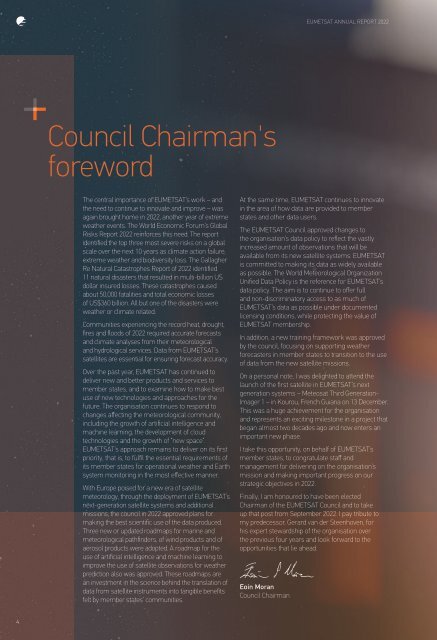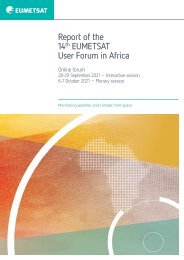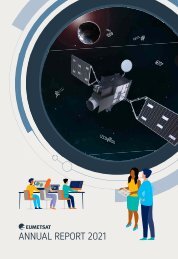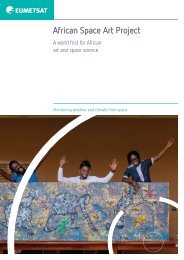EUMETSAT Annual Report 2022
You also want an ePaper? Increase the reach of your titles
YUMPU automatically turns print PDFs into web optimized ePapers that Google loves.
<strong>EUMETSAT</strong> ANNUAL REPORT <strong>2022</strong><br />
Council Chairman's<br />
foreword<br />
The central importance of <strong>EUMETSAT</strong>’s work – and<br />
the need to continue to innovate and improve – was<br />
again brought home in <strong>2022</strong>, another year of extreme<br />
weather events. The World Economic Forum’s Global<br />
Risks <strong>Report</strong> <strong>2022</strong> reinforces this need. The report<br />
identified the top three most severe risks on a global<br />
scale over the next 10 years as climate action failure,<br />
extreme weather and biodiversity loss. The Gallagher<br />
Re Natural Catastrophes <strong>Report</strong> of <strong>2022</strong> identified<br />
11 natural disasters that resulted in multi-billion US<br />
dollar insured losses. These catastrophes caused<br />
about 50,000 fatalities and total economic losses<br />
of US$360 billion. All but one of the disasters were<br />
weather or climate related.<br />
Communities experiencing the record heat, drought,<br />
fires and floods of <strong>2022</strong> required accurate forecasts<br />
and climate analyses from their meteorological<br />
and hydrological services. Data from <strong>EUMETSAT</strong>’s<br />
satellites are essential for ensuring forecast accuracy.<br />
Over the past year, <strong>EUMETSAT</strong> has continued to<br />
deliver new and better products and services to<br />
member states, and to examine how to make best<br />
use of new technologies and approaches for the<br />
future. The organisation continues to respond to<br />
changes affecting the meteorological community,<br />
including the growth of artificial intelligence and<br />
machine learning, the development of cloud<br />
technologies and the growth of “new space”.<br />
<strong>EUMETSAT</strong>’s approach remains to deliver on its first<br />
priority, that is, to fulfil the essential requirements of<br />
its member states for operational weather and Earth<br />
system monitoring in the most effective manner.<br />
With Europe poised for a new era of satellite<br />
meteorology, through the deployment of <strong>EUMETSAT</strong>’s<br />
next-generation satellite systems and additional<br />
missions, the council in <strong>2022</strong> approved plans for<br />
making the best scientific use of the data produced.<br />
Three new or updated roadmaps for marine and<br />
meteorological pathfinders, of wind products and of<br />
aerosol products were adopted. A roadmap for the<br />
use of artificial intelligence and machine learning to<br />
improve the use of satellite observations for weather<br />
prediction also was approved. These roadmaps are<br />
an investment in the science behind the translation of<br />
data from satellite instruments into tangible benefits<br />
felt by member states’ communities.<br />
At the same time, <strong>EUMETSAT</strong> continues to innovate<br />
in the area of how data are provided to member<br />
states and other data users.<br />
The <strong>EUMETSAT</strong> Council approved changes to<br />
the organisation’s data policy to reflect the vastly<br />
increased amount of observations that will be<br />
available from its new satellite systems. <strong>EUMETSAT</strong><br />
is committed to making its data as widely available<br />
as possible. The World Meteorological Organization<br />
Unified Data Policy is the reference for <strong>EUMETSAT</strong>’s<br />
data policy. The aim is to continue to offer full<br />
and non-discriminatory access to as much of<br />
<strong>EUMETSAT</strong>’s data as possible under documented<br />
licensing conditions, while protecting the value of<br />
<strong>EUMETSAT</strong> membership.<br />
In addition, a new training framework was approved<br />
by the council, focusing on supporting weather<br />
forecasters in member states to transition to the use<br />
of data from the new satellite missions.<br />
On a personal note, I was delighted to attend the<br />
launch of the first satellite in <strong>EUMETSAT</strong>’s next<br />
generation systems – Meteosat Third Generation-<br />
Imager 1 – in Kourou, French Guiana on 13 December.<br />
This was a huge achievement for the organisation<br />
and represents an exciting milestone in a project that<br />
began almost two decades ago and now enters an<br />
important new phase.<br />
I take this opportunity, on behalf of <strong>EUMETSAT</strong>’s<br />
member states, to congratulate staff and<br />
management for delivering on the organisation’s<br />
mission and making important progress on our<br />
strategic objectives in <strong>2022</strong>.<br />
Finally, I am honoured to have been elected<br />
Chairman of the <strong>EUMETSAT</strong> Council and to take<br />
up that post from September <strong>2022</strong>. I pay tribute to<br />
my predecessor, Gerard van der Steenhoven, for<br />
his expert stewardship of the organisation over<br />
the previous four years and look forward to the<br />
opportunities that lie ahead.<br />
Eoin Moran<br />
Council Chairman<br />
4









